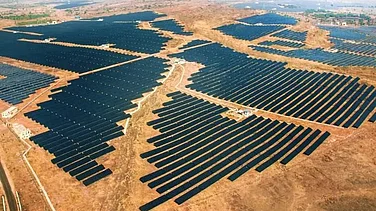Banxit, or, the mass defection of global banking giants from the Net-Zero Banking Alliance (NZBA) threatens to plunge India’s climate ambitions into rough weather. Reason? India is 40% dependent on external funding to fuel its renewable energy projects. With the big banks pulling the plug, India’s net-zero agenda, therefore, risks running out of gas unless it is able to quickly diversify its funding sources.
The facts are stark enough: India must mobilise a daunting $1 trillion to achieve its renewable energy goals by 2030. Given the reluctance of Indian banks and financial institutions to increase their exposure in the renewable sector, banxit could pose a particularly intractable challenge to the country’s fast-growing need for capital.
The UN-backed Glasgow Financial Alliance for Net Zero (GFANZ) set the context for the formation of the NZBA, a congress of 140 leading global banks that pledged to align their portfolios with 2050 net-zero goals by prioritising clean energy investments. However, the exodus of US bank majors led by the likes of JP Morgan Chase, Citigroup and Goldman Sachs, signals their flagging resolve and foreshadows a possible financial flameout for sustainability projects of economies in the Global South and beyond, across the developing world. “The exit of six leading US banks from the NZBA is a severe blow to global climate efforts,” says Rahul Prithiani, Senior Director at CRISIL Intelligence. “This dilutes international climate diplomacy and sends a chilling signal to emerging markets reliant on external funding.”
The exodus has been triggered essentially by concerns roiling financial institutions in the US and, to a lesser degree, G7 nations over climate commitments, charges of greenwashing, potential antitrust suits and fears of a political backlash. These concerns are not unfounded with legal challenges, particularly in the US, slam-dunking financial institutions over many of these issues in the recent past. Contributing to the anxiety is the impending MAGA-driven political shift in the US which many fear could unleash a strong pushback against ESG initiatives. Says Shantanu Srivastava, Research Lead, Sustainable Finance & Climate Risk, IEEFA, "Banks are stepping away from net-zero alliances, partly due to fears of Trump’s return and potential penalties for climate commitments. However, this is also a convenient excuse to regain flexibility in setting their own targets without external scrutiny."
India’s Growing Renewable Energy Needs
For a realistic chance of achieving its ambitious milestones of 500GW of non-fossil power generation capacity and net-zero by 2070, India needs investments exceeding $10 trillion, according to a Climate Positive Initiative (CPI) projection. Already, India has invested an estimated $158 billion of external capital in its green energy projects since 2016, which, according to a BloombergNEF report, was 39% of all investments in the country’s renewable energy. In other words, close to 40% of the renewable energy funding in the country came from the very foreign banks that have now walked out of the NZBA.
According to an IEEFA estimate, India’s renewable energy sector attracted $14.5 billion in FDI in 2022 alone with flagship projects like the Rewa Ultra Mega Solar Park and wind farms in Tamil Nadu, relying heavily on international financing, including contributions from NZBA members. These and dozens of similar projects could now be at risk, particularly with public sector banks (PSBs) unlikely to step up and fill the void, if recent trends are anything to go by. Since 2016, PSBs have contributed just 1% to India’s renewable energy investment corpus and private Indian banks have pitched in with 19%. Explains Jitendra Kumar, VP – Head Corporate Finance, Hero Future Energies: "Public sector banks have been cautious due to perceived risks, delays in discom payments, and concerns over emerging technologies." Despite a few positive signals, this entrenched conservatism shows no signs of easing in the near future. Srivastava at IEEFA adds: "While banks might finance corporates like Tata or Adani at the parent level, they are most unlikely to fund high-risk emerging technologies like green hydrogen or CCUS."
Potential Fallout from the Bank Exodus
Among the options available to India to navigate the crisis are green bonds, sovereign wealth funds, bilateral loans, and multilateral funding from institutions like the World Bank and the Asian Development Bank. However, even collectively, these options are unlikely to provide the scale of funding India needs. “While segments like solar, where there is clear economic viability, are less of a concern, nascent industries such as green steel and cement could face significant challenges. For India, it is now crucial to explore innovative strategies and enhance domestic fundraising. With a robust banking system and dedicated infrastructure financing institutions, these entities must step up to support the country's growing needs,” said Abhishek Saxena, Former Public Policy Expert at Niti Aayog.
He added that India should continue its diplomatic efforts to urge developed countries to provide more financing to developing countries, following the principles of Common but Differentiated Responsibilities (CBDR).
Moreover, as Srivastava at IEEFA points out, "Despite these exits, many institutions remain committed, with trillions of dollars in assets still aligned with net-zero goals." However, without the oversight of an alliance like NZBA, which pins them down to commitments, will these commercial banking majors opt to stick their necks out in potentially risky renewable energy projects overestablished, high return investment options? Most experts agree this shift is improbable.
The indubitable reality, therefore, is that the NZBA implosion poses a risk to India's ability to honour its Paris Agreement commitments. It could also stall its renewable energy projects, undermine its efforts to decarbonise key sectors like power, transport, and core industry, and deepen its reliance on fossil fuels. This, in turn, could unleash a cascade of adverse climate-related consequences jeopardising the lives and livelihoods of millions.
India’s renewable energy sector stands at a precarious juncture, a fact underlined by the banxit. Emerging economies need to smell the coffee and wake up to the fact that the world is balanced on fragile climate finance frameworks and must, therefore, develop resilient funding mechanisms of their own. Therefore, in the aftermath of the walkout, India must focus on diversifying its funding sources, leveraging domestic capital markets and promoting innovation in green finance.
To stay on track, India must diversify its funding sources, leverage domestic capital markets, and foster innovation in green finance. Cementing partnerships with multilateral agencies and incentivising private sector participation will also be key. As the world grapples with the fallout from the NZBA defections, India’s response will test its ability to balance ambition with pragmatism. The stakes are high—not just for its climate goals but for its role as a global leader in clean energy transition.
































